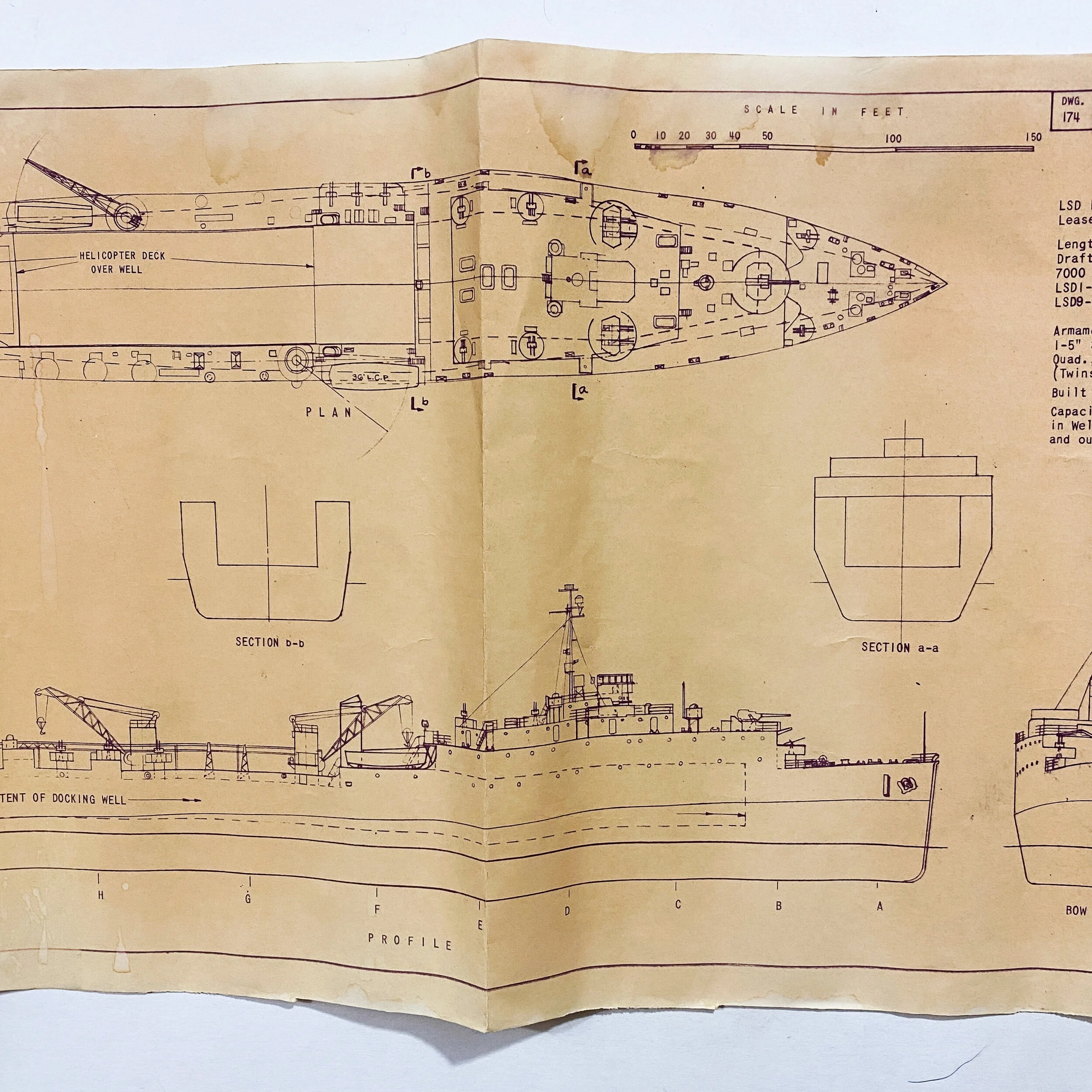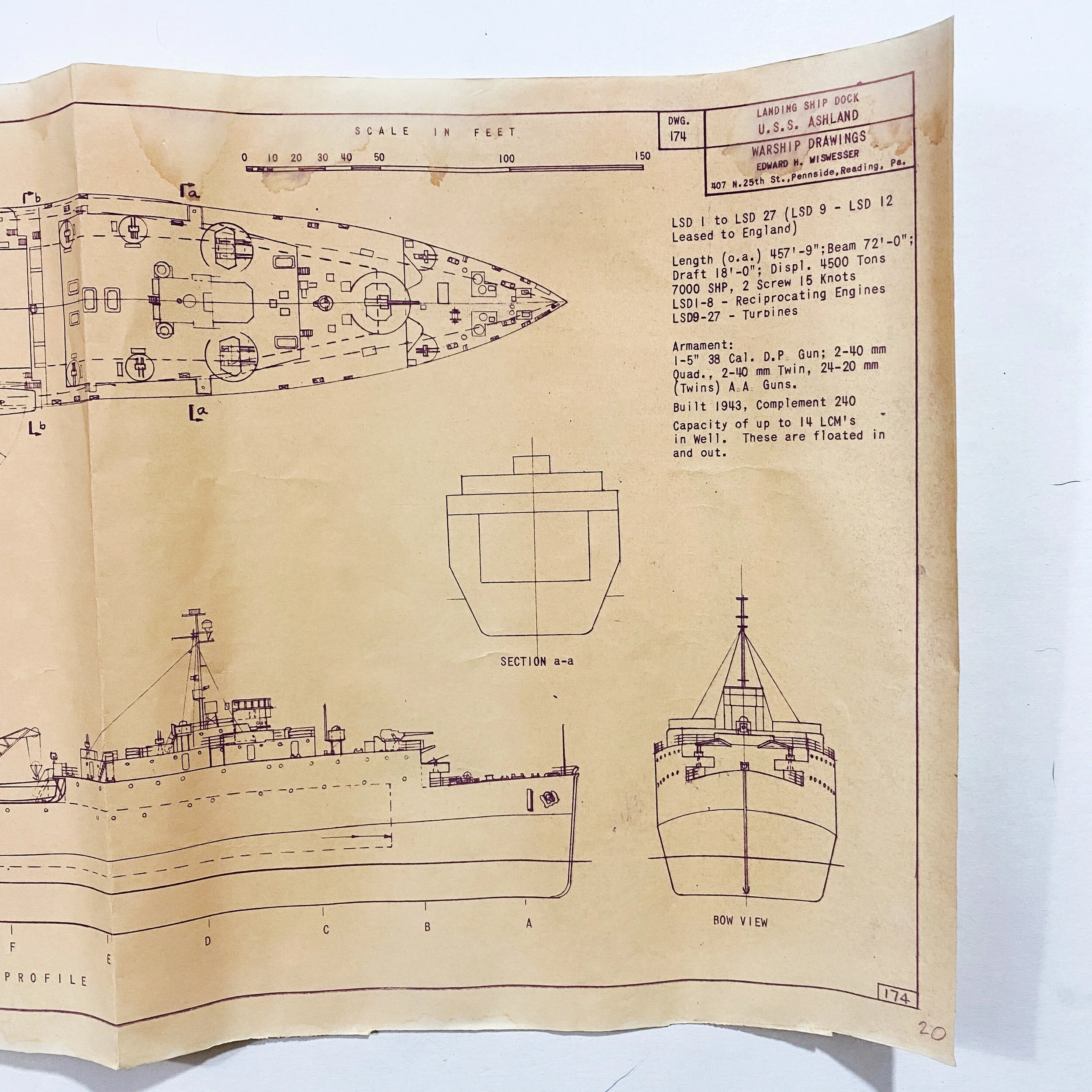Landing Ship Dock U.S.S. Ashland Layout Blueprint - Drawing 174 - Edward H. Wiswesser



















Landing Ship Dock U.S.S. Ashland Layout Blueprint - Drawing 174 - Edward H. Wiswesser
From the personal blueprint collection of Edward H. Wiswesser.
*USS Ashland (LSD-1) participated in the assault on the Marshall Islands, Assault on Eniwetok, Assault on the Marianas, Invasion of Saipan, Invasion of Tinian, Invasion of the Philippines, Battle of Iwo Jima, and Okinawa.
Size: 11.5 x 20.5 inches
This blueprint comes from the blueprint collection of the famous Edward H. Wiswesser. From 1940-1946, Edward H. Wiswesser worked at the Philadelphia Naval Yard designing warships for the United States Navy, specalizing in Iowa-class battleships including his direct hand in designing the Battleships USS New Jersey and the USS Wisconsin. His design of the USS New Jersey was one of the Iowa-class "fast battleship" designs planned in 1938 by the Preliminary Design Branch at the Bureau of Construction and Repair. She was launched on December 7th of 1942 (the first anniversary of the attack on Pearl Harbor) and was commissioned on 23 May 1943. The ship was the second of the Iowa class to be commissioned by the U.S. Navy. The USS New Jersey (BB-62) ("Big J" or "Black Dragon") was the second ship of the United States Navy to be named after the US state of New Jersey. New Jersey earned more battle stars for combat actions than the other three completed Iowa-class battleships, and was the only US battleship providing gunfire support during the Vietnam War. During World War II, New Jersey shelled targets on Guam and Okinawa, and screened aircraft carriers conducting raids in the Marshall Islands. Edward H. Wiswesser other design of the USS Wisconsin (BB-64) is an Iowa-class battleship, the second ship of the United States Navy to be named in honor of the U.S. state of Wisconsin. She was built at the Philadelphia Naval Shipyard in Philadelphia, Pennsylvania and launched on December 7, 1943 (the second anniversary of the Pearl Harbor raid), sponsored by the wife of Governor Walter Goodland of Wisconsin. During her career, Wisconsin served in the Pacific Theater of World War II, where she shelled Japanese fortifications and screened United States aircraft carriers as they conducted air raids against enemy positions.
This specific blueprint is labeled as drawing number 174 and is titled “Landing Ship Dock U.S.S. Ashland’ (LSD 1 - LSD 27). The blueprint itself is also title ‘Warship Drawings’ and contains the name of Edward H. Wiswesser himself. This blueprint details LSD 1-27 with a mark that LSD 9-12 being leased to England. The blueprint contains some of the most detailed and intricate constructional layouts of the ship as well as detailed measurements of its length, knot speed, arraignment, guns and turret attachments. The blueprint itself is in relatively good condition for its age with minor creasing and tears.
This United States Navy blueprint of one of the most infamous ships of WWII would make an amazing addition to any World War II or U.S. Navy collection.
USS Ashland (LSD-1):
Following two months of trials, the dock landing ship loaded amphibious craft and personnel at San Diego, stood out to sea on 11 August, and headed west. After arriving at Pearl Harbor on 19 August, the ship paused to take on more cargo and sailed on 25 August for Baker Island. Ashland reached that destination on 1 September, unloaded her equipment, and returned to Hawaii on 27 September. Following voyage repairs, and the embarkation of Army troops, she sailed on 19 October for New Caledonia. At Nouméa, the ship loaded tanks and marines and proceeded to Efate where she joined Task Force 53 (TF 53) to take part in amphibious assault exercises in the Gilbert Islands area which she completed on 28 November and set a course for Hawaii. She arrived at Pearl Harbor on 7 December and then commenced an availability period for voyage repairs and alterations.
On 11 January 1944, the vessel got underway for amphibious exercises off Maui. She sortied with TF 52 on 23 January for the assault on the Marshall Islands. From 1 February to 5 February, Ashland was involved in assaults on Kwajalein Island and on several of the other small islands in the atoll that bears the same name. On 15 February, the ship embarked marines and equipment at Roi-Namur and proceeded to the assault on Eniwetok. The ship entered Eniwetok Atoll on 17 February and served as a repair ship through 29 February. On that day, she got underway for Pearl Harbor.
After a period of availability and operations in Hawaiian waters, the ship headed for the West Coast of the United States. She reached San Francisco on 1 April, began loading landing craft, and was back in Pearl Harbor on 17 April. Ashland then conducted training exercises off Maui before leaving Hawaii on 29 May for the initial assault on the Marianas. She launched boats for the invasion on Saipan on 15 June and then assumed duties as a repair ship. On 8 July, Ashland sailed to Eniwetok for fuel and supplies.
The ship's next assignment was the invasion of Tinian on 24 July. She left the Marianas on 28 July and returned via Eniwetok to Pearl Harbor. Ashland underwent repairs and held amphibious landing exercises before sailing with Task Group 33.1 (TG 33.1) for the assault on Yap and Ulithi. Ashland was diverted to Manus Island where she was assigned to TF 79 and prepared for the invasion of the Philippines. The ship sailed on 14 October and launched her boats on the 20th for the first assault against Leyte. Ashland left the combat area on 22 October and proceeded to Hollandia, New Guinea. There, she embarked troops for transportation to the Philippines; and, after delivering them to Leyte, she returned to Hollandia on 21 November.
Ashland headed for Cape Gloucester on 28 November for training exercises. Three days later, she got underway for Lingayen Gulf and the occupation of Luzon. All her equipment was unloaded by 12 January 1945, and Ashland retired toward Leyte. She continued on to Ulithi where she was reassigned to the 5th Fleet. The ship proceeded to Guam on 7 February, loaded 18 amphibious craft, and sailed to Saipan. There, she took on spare parts and more troops. On 12 February and 13 February, Ashland participated in landing rehearsals at Tinian. She sailed for Iwo Jima on 16 February and began launching her boats on the 19th. Despite continuing air attacks, Ashland's crew carried out repair work on schedule until she finally withdrew to Eniwetok on 31 March.
Ashland entered Pearl Harbor on 13 April and underwent an availability. She took on amphibious craft late in May and got underway for the Philippines on 3 June. She touched at Samar on 1 July to embark PT boats and their crews for transportation to Kerama Retto. The ship sailed on 3 July, unloaded her charges, and returned to Leyte on 10 July. She shuttled a similar cargo to Okinawa soon thereafter and arrived at Eniwetok on 7 August to refuel. The war ended on 15 August while Ashland was steaming independently to Espiritu Santo. After mooring there on 17 August, she proceeded with a load of PT boats to Okinawa.
Then she next sailed for Jinsen, Korea, and arrived there on 29 September. She remained at that port two days before getting underway for Leyte for a three-week availability before returning to Okinawa in late October. Ashland continued her duty of carrying and tending landing craft in the Far East until January 1946. Shortly thereafter she returned to the United States and was placed out of commission, in reserve, in March 1946 at San Diego.